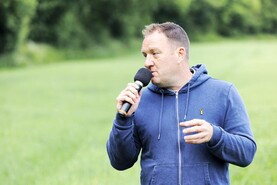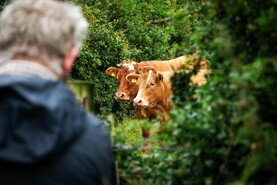Oatly, the Swedish company behind the oat drink brand, has spent many years making substantial losses for its shareholders. Its most recent report, for the first quarter of 2024, showed that while there was some slowdown in the pace of losses, they were still running at more than $500,000 (€468,000) per day.
These years of losses mean the vast majority of the company’s equity capital has been wiped out, and last year had to borrow $425m (€398m) at an interest rate of almost 10% from investors. Those interest charges alone will cause a major headwind for any chances of profitability over the coming years.
The movement in the company’s financial position can be clearly seen in the chart (see Figure 1) where assets have shrunk as liabilities – excluding equity capital – have rapidly increased. Every year the company reports another loss eats further into that position. The performance in the most recent three months will only further eat into that.
This is all a long way from March 2021 when the company listed on the Nasdaq stock exchange, raising just over $1bn (€940m) from investors. The listing was by means of an ADR (an American depository receipt which allows non-US companies to trade on US markets. It is basically a share that equals one ordinary share in Sweden-based Oatly) had an offering price of $17 (€15.91). The enthusiasm for the listing was huge, with the ADR trading close to $30 by mid-June.
That point, however, proved a high-water mark for the value of the company, with Oatly facing a significant reversal in fortunes, which saw its ADRs tumble to $8 (€7.50) by the end of 2021, and continue its fall to the current level of less that one dollar.
There were three main drivers of the collapse in the share price – other than the inability of the company to actually make money from selling fake milk. Firstly, Oatly was subject to a report which accused it of green-washing its environmental credentials. There was a class-action lawsuit launched by US investors which claimed the company had “artificially pumped” its public offering by over-promoting demand for its products and claiming it was more environmentally sound than it was.
That lawsuit was settled in February of this year for $9.25m (€8.7m), with investors having until 25 July to submit a claim and get a share of that money. While the size of the settlement has not been that large for Oatly, the reputational damage done has been huge.
In the days after the initial US listing, CEO of Oatly Toni Petersson said in an interview with US financial TV channel CNBC that trust in a company is very important and “unless you are transparent and honest about what you do, you really don’t earn that trust”.
The second major problem for Oatly has been the speed at which it tried to expand. One of the major failings listed by the company under its ‘green’ credentials was how much product it was shipping around the world – manufacturing fake milk in Sweden and shipping it to China, for example. The company set about plans to expand productive capacity, with new manufacturing facilities planned for the UK and Texas in the US.
However, last year it announced that it was abandoning plans for the facilities which led to impairment charges totalling $201.6m (€188.6m). Oatly also sold a manufacturing facility in Utah, US to a Canadian company, which will continue to make Oatly products from raw materials supplied by the Swedish company.
‘Asset-light’ strategy
Petersson described the deal as part of an “asset-light” strategy which would help the company’s cashflow. Speaking of cashflow, Petersson himself was ousted as CEO of the company in May of 2023, replaced by food-industry veteran Jean-Christophe Faltin. Petersson, who was CEO since 2012 was appointed as co-chair of the company and received a payment of $942,000 (€881,000) as part of his severance.
The third problem for Oatly is that its product is not that difficult to reproduce, and the market for fake milk based on oats has become increasingly saturated with competitors in recent years.
Consumer demand
Consumer demand for fake milk in general has failed to grow as forecast, with growth in the key US market rising less than 1% last year, according to market-research company Circana. When looking at market share, Oatly is in fourth place in the US. While its sales were 11.4% higher in the first three months of this year by volume, the sales revenue only increased by 4.6%, implying that Oatly had to cut prices in order to gain market share.
The risk for Oatly, however, is that it has burned through too much investor money, and recently taken on too much debt for it to ever be competitive in key markets. New entrants, such as Tirlán and Kerry’s Smug brand of hybrid oat and milk, can piggyback on current retail relationships and manufacturing knowledge in order to reduce costs. Those companies are not burdened with large interest payments, which will have to be met before a single cent of profit can be wrangled from any litre of product sold.
Oatly may well find that in trying to expand too rapidly, it flew too close to the sun and is already coming crashing back down to earth.
Comment
Rapid expansion to meet demand that failed to materialise a mistake
In the fake-milk market Oatly certainly had something called early-mover advantage. It was the first oat-based product on shelves in many countries and its quirky marketing campaign certainly helped the company get a lot of coverage and become well-known among consumers.
But the company made a fundamental business mistake in trying to rapidly expand to meet demand that failed to fully materialise. This may be a case of a company believing its own hype too much. Petersson said in 2021 that “we don’t even see ourselves as an oat-milk maker, we’re a people and sustainability company”.
That might sound very laudable and even appealing to the millennial and generation Z customers his company was targeting, but the business reality will always eventually catch up with such slogans if they are not backed by a profitable product.
As Oatly is already finding out, a business plan based on good intentions rather than the bottom line can soon run out of other people’s money.
Comment: Rapid expansion to meet demand that failed to materialise a mistake
In the fake-milk market Oatly certainly had something called early-mover advantage. It was the first oat-based product on shelves in many countries and its quirky marketing campaign certainly helped the company get a lot of coverage and become well-known among consumers.
But the company made a fundamental business mistake in trying to rapidly expand to meet demand that failed to fully materialise. This may be a case of a company believing its own hype too much. Petersson said in 2021 that “we don’t even see ourselves as an oat-milk maker, we’re a people and sustainability company”.
That might sound very laudable and even appealing to the millennial and generation Z customers his company was targeting, but the business reality will always eventually catch up with such slogans if they are not backed by a profitable product.
As Oatly is already finding out, a business plan based on good intentions rather than the bottom line can soon run out of other people’s money.
Oatly, the Swedish company behind the oat drink brand, has spent many years making substantial losses for its shareholders. Its most recent report, for the first quarter of 2024, showed that while there was some slowdown in the pace of losses, they were still running at more than $500,000 (€468,000) per day.
These years of losses mean the vast majority of the company’s equity capital has been wiped out, and last year had to borrow $425m (€398m) at an interest rate of almost 10% from investors. Those interest charges alone will cause a major headwind for any chances of profitability over the coming years.
The movement in the company’s financial position can be clearly seen in the chart (see Figure 1) where assets have shrunk as liabilities – excluding equity capital – have rapidly increased. Every year the company reports another loss eats further into that position. The performance in the most recent three months will only further eat into that.
This is all a long way from March 2021 when the company listed on the Nasdaq stock exchange, raising just over $1bn (€940m) from investors. The listing was by means of an ADR (an American depository receipt which allows non-US companies to trade on US markets. It is basically a share that equals one ordinary share in Sweden-based Oatly) had an offering price of $17 (€15.91). The enthusiasm for the listing was huge, with the ADR trading close to $30 by mid-June.
That point, however, proved a high-water mark for the value of the company, with Oatly facing a significant reversal in fortunes, which saw its ADRs tumble to $8 (€7.50) by the end of 2021, and continue its fall to the current level of less that one dollar.
There were three main drivers of the collapse in the share price – other than the inability of the company to actually make money from selling fake milk. Firstly, Oatly was subject to a report which accused it of green-washing its environmental credentials. There was a class-action lawsuit launched by US investors which claimed the company had “artificially pumped” its public offering by over-promoting demand for its products and claiming it was more environmentally sound than it was.
That lawsuit was settled in February of this year for $9.25m (€8.7m), with investors having until 25 July to submit a claim and get a share of that money. While the size of the settlement has not been that large for Oatly, the reputational damage done has been huge.
In the days after the initial US listing, CEO of Oatly Toni Petersson said in an interview with US financial TV channel CNBC that trust in a company is very important and “unless you are transparent and honest about what you do, you really don’t earn that trust”.
The second major problem for Oatly has been the speed at which it tried to expand. One of the major failings listed by the company under its ‘green’ credentials was how much product it was shipping around the world – manufacturing fake milk in Sweden and shipping it to China, for example. The company set about plans to expand productive capacity, with new manufacturing facilities planned for the UK and Texas in the US.
However, last year it announced that it was abandoning plans for the facilities which led to impairment charges totalling $201.6m (€188.6m). Oatly also sold a manufacturing facility in Utah, US to a Canadian company, which will continue to make Oatly products from raw materials supplied by the Swedish company.
‘Asset-light’ strategy
Petersson described the deal as part of an “asset-light” strategy which would help the company’s cashflow. Speaking of cashflow, Petersson himself was ousted as CEO of the company in May of 2023, replaced by food-industry veteran Jean-Christophe Faltin. Petersson, who was CEO since 2012 was appointed as co-chair of the company and received a payment of $942,000 (€881,000) as part of his severance.
The third problem for Oatly is that its product is not that difficult to reproduce, and the market for fake milk based on oats has become increasingly saturated with competitors in recent years.
Consumer demand
Consumer demand for fake milk in general has failed to grow as forecast, with growth in the key US market rising less than 1% last year, according to market-research company Circana. When looking at market share, Oatly is in fourth place in the US. While its sales were 11.4% higher in the first three months of this year by volume, the sales revenue only increased by 4.6%, implying that Oatly had to cut prices in order to gain market share.
The risk for Oatly, however, is that it has burned through too much investor money, and recently taken on too much debt for it to ever be competitive in key markets. New entrants, such as Tirlán and Kerry’s Smug brand of hybrid oat and milk, can piggyback on current retail relationships and manufacturing knowledge in order to reduce costs. Those companies are not burdened with large interest payments, which will have to be met before a single cent of profit can be wrangled from any litre of product sold.
Oatly may well find that in trying to expand too rapidly, it flew too close to the sun and is already coming crashing back down to earth.
Comment
Rapid expansion to meet demand that failed to materialise a mistake
In the fake-milk market Oatly certainly had something called early-mover advantage. It was the first oat-based product on shelves in many countries and its quirky marketing campaign certainly helped the company get a lot of coverage and become well-known among consumers.
But the company made a fundamental business mistake in trying to rapidly expand to meet demand that failed to fully materialise. This may be a case of a company believing its own hype too much. Petersson said in 2021 that “we don’t even see ourselves as an oat-milk maker, we’re a people and sustainability company”.
That might sound very laudable and even appealing to the millennial and generation Z customers his company was targeting, but the business reality will always eventually catch up with such slogans if they are not backed by a profitable product.
As Oatly is already finding out, a business plan based on good intentions rather than the bottom line can soon run out of other people’s money.
Comment: Rapid expansion to meet demand that failed to materialise a mistake
In the fake-milk market Oatly certainly had something called early-mover advantage. It was the first oat-based product on shelves in many countries and its quirky marketing campaign certainly helped the company get a lot of coverage and become well-known among consumers.
But the company made a fundamental business mistake in trying to rapidly expand to meet demand that failed to fully materialise. This may be a case of a company believing its own hype too much. Petersson said in 2021 that “we don’t even see ourselves as an oat-milk maker, we’re a people and sustainability company”.
That might sound very laudable and even appealing to the millennial and generation Z customers his company was targeting, but the business reality will always eventually catch up with such slogans if they are not backed by a profitable product.
As Oatly is already finding out, a business plan based on good intentions rather than the bottom line can soon run out of other people’s money.






 This is a subscriber-only article
This is a subscriber-only article










SHARING OPTIONS: